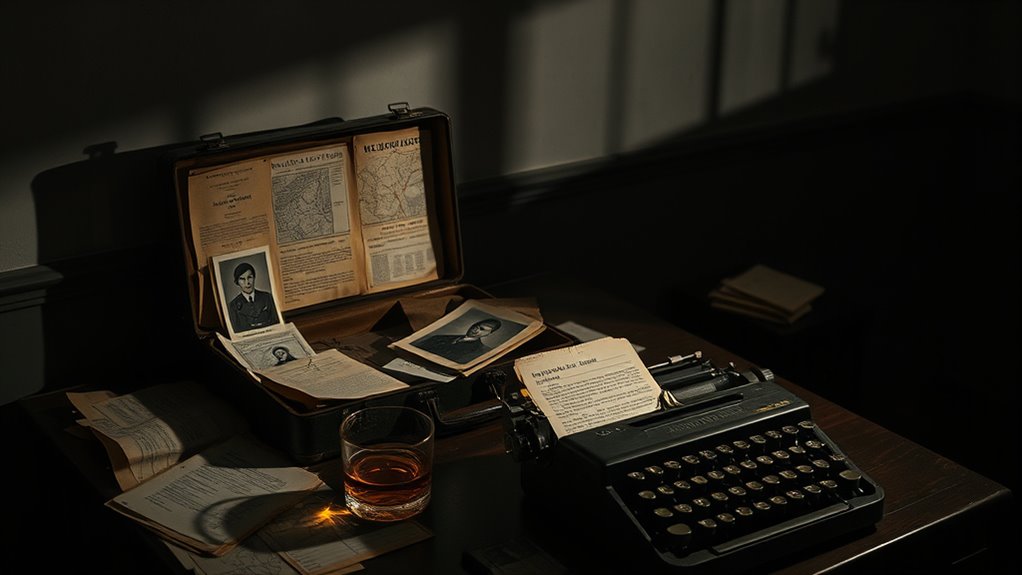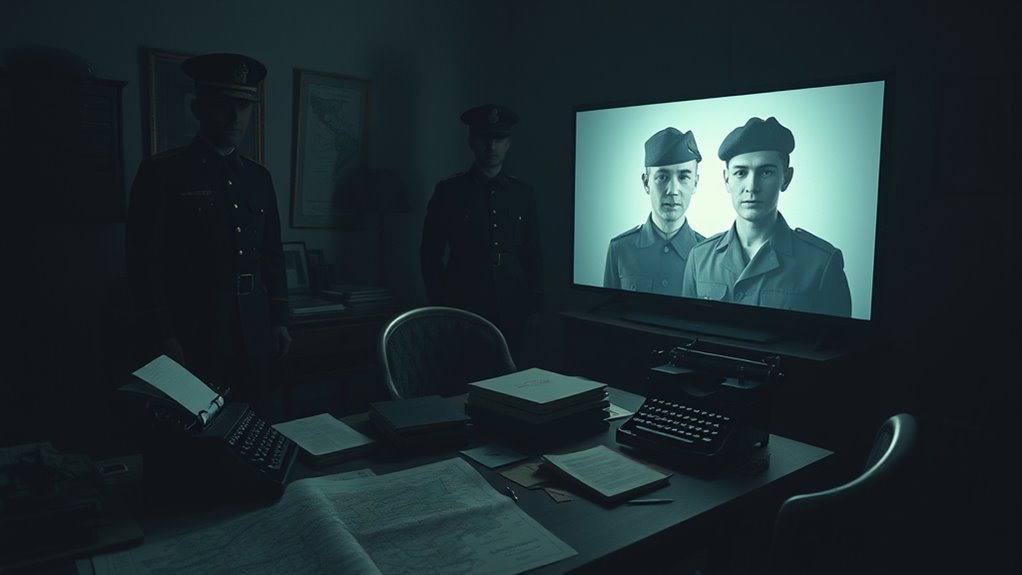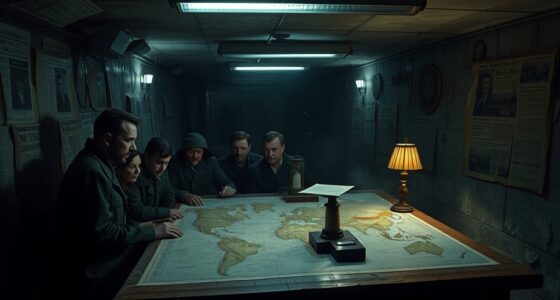Operation Mincemeat showcases how deception in warfare can mislead and manipulate. By using a corpse disguised as a British officer and planting false documents, it successfully diverted German forces during WWII. This meticulous planning laid the groundwork for modern disinformation tactics, like deepfakes and AI-generated misinformation. Today, understanding these historical strategies helps you recognize similar tactics being used online. Stick around to uncover how you can combat such modern-day deceptions.
Key Takeaways
- Operation Mincemeat exemplified strategic deception, laying groundwork for future misinformation tactics in warfare, including AI-generated content.
- The meticulous planning of false narratives in Operation Mincemeat parallels modern techniques used in deepfakes and generative AI.
- Just as false documents misled the enemy in WWII, today's misinformation exploits technology to create hyper-realistic, deceptive content.
- The rapid dissemination of false information seen during Operation Mincemeat foreshadowed the sixfold speed of misinformation spread on social media today.
- Vulnerable populations, once targeted by WWII deception, now face similar risks from AI-generated misinformation due to a lack of digital literacy.
The Historical Blueprint: Operation Mincemeat and Its Deceptive Genius

Although it might seem improbable, Operation Mincemeat stands as a brilliant example of military deception that changed the course of World War II.
By using a corpse disguised as a British officer, you see how clever deception can mislead even the most formidable enemies. Intelligence officers Ewen Montagu and Charles Cholmondeley crafted an intricate ruse, planting false documents that made the operation convincing.
A brilliant ruse involving a disguised corpse and false documents misled the enemy, showcasing the power of clever deception in warfare.
This masterstroke of information warfare diverted German forces away from Sicily, allowing the Allies to land with minimal resistance.
The operation not only showcased the power of deception in military strategy but also set a historical blueprint for future intelligence operations. Its principles resonate today, especially as we navigate the challenges of AI-driven disinformation tactics like deepfakes.
The Evolution of Deception: From WWII to Modern Information Warfare

As the landscape of warfare has evolved, so too have the tactics of deception that underpin it. Operation Mincemeat exemplified how meticulously planned deception tactics could mislead the enemy, diverting attention from the real invasion point in Sicily.
Fast forward to today, and the rapid spread of misinformation through social media mirrors those strategic efforts, although on a much larger scale. Just like the Allies exploited enemy trust in authentic documents, modern information warfare utilizes advanced technology to fabricate and disseminate false narratives.
The legacy of WWII's deception strategies continues to influence current intelligence operations, highlighting the need for robust detection methods to combat the challenges posed by AI-generated misinformation. Adapting to these changes is essential for maneuvering today's digital battlefield.
Deepfakes and Generative AI: The New Frontier of Misinformation

The rise of deepfakes and generative AI marks a new chapter in the evolution of misinformation, building on the deception tactics established during WWII.
These technologies create hyper-realistic content, making it harder for you to discern truth from falsehood. Here's what you need to know:
- Speed of Spread: False information travels six times faster than the truth on social media, thanks to AI-generated misinformation.
- Vulnerability: A lack of deepfake literacy leaves you susceptible to manipulated content, especially evident during the Russian-Ukrainian war.
- Exploitation: Cybercriminals leverage deepfakes to scam individuals by impersonating credible public figures.
With advancements in AI, the need for effective deepfake detection tools has never been more urgent. Continuous advancements in algorithms enhance our ability to combat such misinformation.
Stay informed and vigilant against this new frontier of misinformation.
Identifying the Targets: Who Falls Victim to Digital Deception?

While anyone can fall victim to digital deception, certain demographics are more vulnerable to manipulation. Individuals with lower education levels or income often find themselves targeted by misleading content, making them easier prey for misinformation tactics.
Research shows that audiences are profiled and served tailored false narratives based on their online behaviors and preferences, which enhances the effectiveness of these strategies.
During events like the Russian-Ukrainian war, many lacked deepfake literacy, demonstrating how readily people can be misled by manipulated content.
Social media platforms act as battlegrounds where misinformation spreads rapidly, influencing public opinion and behaviors.
Ultimately, understanding who's most susceptible can help us recognize the tactics behind digital deception and protect ourselves from becoming unwitting victims.
Solutions in Sight: Strategies for Countering AI-Generated Misinformation

To effectively counter AI-generated misinformation, it's crucial to implement a multi-faceted approach that combines technology, education, and collaboration.
Countering AI-generated misinformation requires a comprehensive strategy that integrates technology, education, and collaboration for maximum impact.
Here are three key strategies:
- Develop Detection Tools: Invest in advanced algorithms to detect deepfakes and other AI-generated content, bolstering your counter-misinformation efforts.
- Real-Time Responses: Create rapid response teams to address false narratives as they emerge, ensuring accurate information is readily available.
- Media Literacy Education: Empower the public through media literacy programs, teaching individuals how to recognize and question misinformation effectively. Additionally, fostering personalized learning experiences can help individuals better understand the context and implications of the information they encounter.
Frequently Asked Questions
What Was the Deception in Operation Mincemeat?
In Operation Mincemeat, the deception involved using a dead body dressed as a Royal Marine officer, complete with fake documents suggesting the Allies would invade Greece instead of Sicily.
You'd see how the British intelligence cleverly orchestrated this ruse, planting authentic-looking letters and maps to mislead the Germans.
Did the Germans Fall for Operation Mincemeat?
When it comes to deception, you've got to know when to hold 'em and when to fold 'em.
The Germans definitely fell for Operation Mincemeat. They were convinced by the planted corpse and forged documents that an Allied invasion was aimed at Greece instead of Sicily.
This misdirection led them to fortify the wrong location, ultimately allowing the Allies to successfully invade Sicily in July 1943.
It showcased how powerful strategic deception can be.
Was Jean's Real Operation Mincemeat?
Jean's identity in Operation Mincemeat wasn't real; it was part of a carefully crafted deception.
You see, the British intelligence created a false persona to mislead the Nazis about Allied invasion plans.
This operation involved a corpse, complete with fake documents, to convince German forces that the Allies would attack Greece instead of Sicily.
Conclusion
In the grand tapestry of deception, Operation Mincemeat serves as a timeless thread, weaving lessons that resonate today. As you navigate the murky waters of AI-generated misinformation, remember that awareness is your compass. Just like a lighthouse guiding ships through fog, understanding these tactics can help you steer clear of manipulation. By sharpening your critical thinking skills and fostering digital literacy, you'll be better equipped to face this modern battlefield of disinformation. Stay vigilant; knowledge is your best defense.








